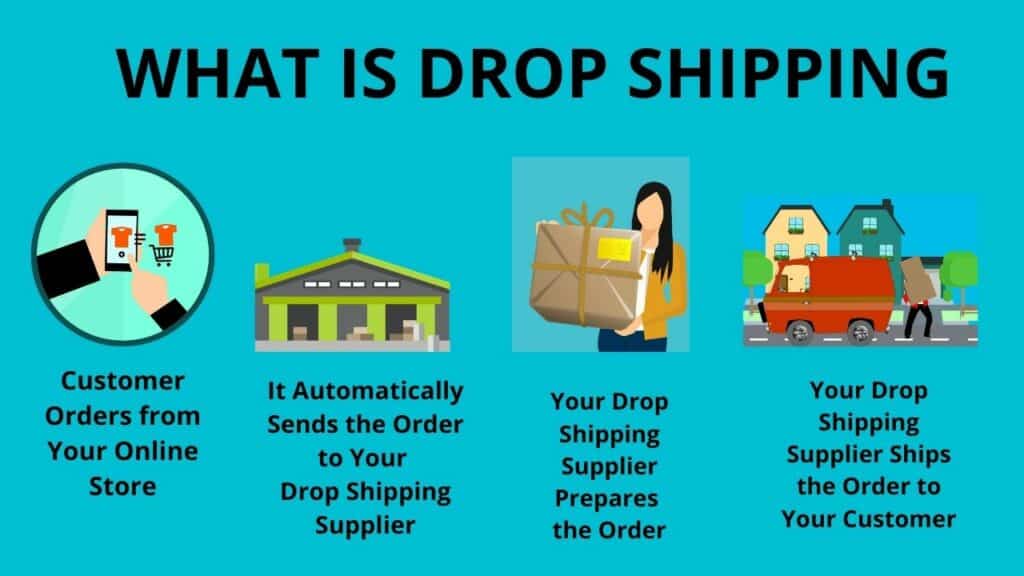Drop shipping has been around since E-commerce first became popular in the early 2000s. It is an extremely versatile industry and can be a stand-alone venture or complement existing companies, even if they don’t specialize in the online marketplace. Lately, another avenue has been gaining popularity in this sphere, you may have recently heard the term Drop Surfing, so what is the difference?
Drop surfing is an addition to drop shipping that helps maximize profits. Traditionally drop shipping is an order fulfillment method through a third-party supplier, whereas drop surfing is the use of multiple third parties and always choosing the supplier with the lowest fulfillment cost at the time of the order.
Drop shipping has many different manifestations in this day and age and has expanded rapidly into all areas of order fulfillment. We will be exploring some of the more successful uses for drop shipping, common pitfalls to avoid if you’re looking to join the industry, or strengthen your current business, as well as exploring when it makes sense to drop surf instead of simply drop ship.
Understanding Drop Shipping

Drop shipping is a very attractive business venture or side venture for those with an entrepreneurial mindset. The name of the game is to operate a storefront or online retail hub and manage the fulfillment of orders directly from a supplier.
This means that manufacturing and order fulfillment is not your direct responsibility. The profit made here for drop shippers is the difference between the cost of a supplier’s product (including shipping) and the listed price of the item on your platform minus your overhead.
Drop shipping is a very competitive industry as it is easy to approach and requires little to no start-up money. That being said, getting established and building a reliable customer base can be a lot more difficult. While drop shipping eliminates the costs associated with manufacturing, storing, and transporting goods, it still requires marketing, an online retail space, and a basic understanding of business and the industry to be successful.
This innovative fulfillment avenue has many different uses, some people build their entire business off of drop shipping alone, while other established retailers may use it to fulfill uncommon products or other items that don’t make sense to keep on store shelves or have taken up space in a warehouse. Many big box stores may also choose to use drop shipping as a way to test a new product before committing precious shelf or inventory space to it as well.
Where Does Drop Surfing Fit In?
Drop Surfing is essentially a more productive method to run a drop shipping business, in such a way that you will make more profit per item. To understand this best, let’s consider that you run a drop shipping store and sell coffee mugs. When a customer orders a mug from your store, you would then have your supplier fulfill the order.
So, you would pay the supplier for manufacturing and shipping the product at their cost, and whatever price above that dollar amount your customer paid will be your profit. So say you have a usual supplier, but now another supplier is having a sale on that same mug and you would save $3 if you were to fulfill the order through this other supplier. Which one would you end up going with?
Naturally, you’d want to fulfill the order through the supplier you would get the best deal with, thus getting more profit for your business. The price on your website stays the same, your customer pays the same, the end product is the same, but if you can source the cheapest fulfillment method, that’s pure profit for you and your business.
Drop Surfing is just the act of using multiple suppliers and choosing the best price for fulfillment with each order. If you end up selling 100 mugs that month, you’ve made $300 more than you would have done with your original supplier.
An alternate definition of Drop Surfing is sometimes considered the idea of “surfing online trends” which means trying to predict or quickly get in on the market for products as they are trending online. This is less favorable than the definition above as it usually means needing to operate multiple different storefronts. This also offers less stability because as trends can tend to change rapidly, you’ll constantly need to be on the lookout for the next one.
The Pros Of Drop Shipping

- Easy To Get Started With Minimal Risk
Drop shipping is a popular method of online retailing, more so than you might think. Today even big box stores like Best Buy or Walmart have taken an interest in drop shipping and it’s easy to see why. You need little to no capital to get started and it can be a surprisingly lucrative and hands-off business venture when done correctly.
Since you don’t need to put any money up for products to fill the shelves like a traditional store the risk is much lower and you limit your exposure to loss. You don’t need to be stressed about inventory not moving because you’re not on the hook for it financially.
Even more attractive is the time it takes to get a drop shipping business started, if you’re eager enough you could have everything up and running in a matter of hours. Besides all of that, since drop shipping has only grown in popularity over the last twenty years, there are more resources available than ever before for those considering getting into drop shipping, as well as those who are already started and want to improve their business model.
- Sustainable And Easy Growth
As mentioned, one of the things that draw people to drop shipping is the lack of need for big investments or funding to get started. This stays consistent throughout growing your business as well. Unlike a brick and mortar store that may require upgrading to a bigger space with more employees, etc., Drop shipping’s overhead costs won’t change very much based on your growth. In fact, as you scale up you won’t need to alter your business model much, if at all.
You may choose to invest in some services that make your life easier, but these aren’t necessary if you’re willing to continue putting in sweat equity. For example, if you choose to incorporate drop surfing into your drop shipping business you may reach a point where sourcing the lowest supplier for each order is not the best use of your time. In that case, you might end up wanting to pay for a service that compiles a database of suppliers and automates the lowest cost for you on each order.
Cons Of Drop Shipping

- Lack Of Quality Control
One big downside of drop shipping is that you need to trust and rely on your suppliers for a big portion of the chain between you and your customers. As the product will bypass you entirely, you’ll need to trust your suppliers are doing everything up to your standards. You are also the one who deals directly with your customers, so you need to be ready and willing to handle any complaints and do your best to fix them, even if you’re not the one directly responsible for the issues.
Drop shippers are essentially paid to be the middleman between a supplier and a customer, so you will need to take that responsibility. Additionally, while you are at the mercy of your supplier, it is still your reputation on the line if problems don’t get fixed and the customer is not happy.
- Slim Margins
At this point with the online commerce space, drop shipping is a very competitive industry. This means that especially on trendy products you can expect to not be the only retailer out there. Some more established sellers may be able to offer lower prices than you can, and often drop shippers will need to dip into their expected profits to stay competitive.
Established brands also have the advantage of customer loyalty which takes some time to build and means they can afford to charge a bit more per product without losing sales. Starting out these are your biggest competitors so you need to offer something to draw those customers to you.
Even on products that are less popular, you’ll often find you may have larger margins due to less competition, but the problem with niche markets is they may not be active enough or sustained enough to warrant profit over the long term. In this way, drop shipping heavily relies on quantity to be profitable.
Setting Yourself Up For Success
What Makes Drop Surfing So Great
Luckily there are ways to combat the cons of drop shipping, and one of the big ones is Drop Surfing. If you’re able to find a supplier to fulfill orders at a lower price than the competition, you have the advantage of being able to list it for a competitive price without cutting too far, if at all into your profit margins. Also, since most customers are often most concerned with the best deal, you can entice new buyers with lower prices.
The pro’s and con’s of Drop Surfing are slightly different than drop shipping, and can also be a double-edged sword. One of the downsides of using multiple suppliers means the potential for inconsistency. Say you have a customer who orders a mug and they have a great experience, the next time they order that exact same mug it may come from a different supplier.
This normally isn’t an issue as long as you trust all of your suppliers to do things right, but if the customers first mug from supplier A came in bubble wrap and their second one comes from supplier B chipped with no bubble wrap, that reflects on you alone as the seller. It might mean a bit of back and forth before you and your various suppliers can find a consistency that you’re comfortable putting your reputation behind.
This can also be an upside in the drop shipping business. This is because having an established relationship with different suppliers means that if one is unable to live up to your standards, or if their quality begins to decline, you’re already set up to keep fulfilling orders through one of your other contacts. This also holds true for any interruption to service. Having one main supplier means that you are entirely at their mercy if they have a shutdown or unexpected inability to fulfill an order.
Choosing Your Suppliers

Choosing a reliable supplier is a huge part of running a successful drop shipping business. Another aspect to explore is the legal liability issues associated with drop shipping. Some suppliers do not operate a legitimate business model, and unfortunately, whether you know that or not, as the vendor you are automatically complicit in any illegal activities that your supplier may be engaging in.
This is especially common with suppliers producing knock off or fake products, especially if they are using a trademarked logo or intellectual property of another company. As an example, even if you’re not the one producing a Louis Vuitton Knockoff handbag you can still be held liable if you are listing and fulfilling orders for one through your shop.
A Productive Business Relationship
As you are the link between your customers and your suppliers, it’s important to take into consideration your relationship with both ends of the chain. Being accountable to your customers and providing great customer service, even with things out of your control is key to a successful drop shipping business. However, it is also important to realize you are entering into effectively a business partnership with your supplier.
The most important thing to think about when choosing a supplier is the quality of the products and that they appear in person as advertised. I’m sure you’ve come across the “what I ordered vs. what I got” memes that are all over the web, it’s likely those drop shippers skipped this step. Providing your customers exactly what is advertised is paramount for growing a good reputation and customer base.
You’ll also want to make sure that their shipping methods meet your expectations, as well as a few other key concerns about their business priorities. Here are some key considerations you’ll want to find out about any potential supplier you use.
- How quickly does their customer support respond, and how good are they?
- How long maximum will it take for orders to get to the customers’ door?
- Do orders have the option to be insured?
- Do they have good reviews?
- What is the return policy on damaged or defective products?
- Do they offer any incentives for choosing them?
- Are they willing to sign a Drop shipping Agreement Contract?
Keeping these points in mind will be crucial for saving yourself a big headache in the long run. The worst thing you can do is find out your supplier’s return policy on the fly while dealing with an unsatisfied customer. Knowing the answers to these questions will also help you establish the priority of the suppliers you choose.
It’s especially important to consider this when drop surfing as even though a product may be $0.50 cheaper from Supplier A, if they have slower shipping and you’ve promised a quick turnaround, Supplier B with the fast shipping might be the better option.
Tips On How To Have A Successful Drop Shipping Business
The customer is king, and bad reviews are the dread of every online supplier and vendor. To truly be successful in this industry you need to avoid as many as possible. Some situations will be especially frustrating as the solution will be out of your hands and up to your suppliers to fix. Luckily lots of situations that end with customers demanding their money back and leaving a negative review can be avoided with some foresight.
- Have a backup supplier even when you’re not drop surfing. This can help you avoid problems with backorders and order fulfillment delays.
- If selling smaller items, store a few at home or in storage you have access to.
- Strong communication lines. Don’t leave your customers waiting for information. If it is going to be delayed – let them know. If something is damaged – get back to them with a solution ASAP.
- See every product you list in person from the supplier before you fulfill customer orders through them.
Stand Out From Other Drop Shipping Stores
Finding a niche of products or personality that makes your store different from others will go a long way to being a successful drop shipper. It’s hard to build a brand when you’re not the person getting acknowledgment for the product or when your logo isn’t on the merchandise, so you’ll have to be creative.
Selling the same thing as everyone else is not easy for unestablished shops even if it does have a better margin in theory than some of the more niche products. It’s usually a good idea to look at different areas you’re marketing to and see what can’t be acquired locally. If you can’t offer the best deal on a popular product, your chance of success is much lower than offering a good deal on a niche product or product that is hard to find locally.
LATEST ARTICLES
- Start Your Financial Journey: Understanding Your Money Landscape!
 Welcome to the start of your financial journey! “Begin Your Financial Journey: Understanding Your Money Landscape!” is more than just a guide; it’s an invitation to explore your financial world. Imagine starting a quest where your income, expenses, and goals come to life, forming a vibrant landscape waiting to be … Read more
Welcome to the start of your financial journey! “Begin Your Financial Journey: Understanding Your Money Landscape!” is more than just a guide; it’s an invitation to explore your financial world. Imagine starting a quest where your income, expenses, and goals come to life, forming a vibrant landscape waiting to be … Read more - Setting Financial Goals: The Foundation of Successful Investing
 After reading countless articles and listening to many respected voices on investing, I’ve learned the keys to success. Yet what’s often overlooked is the foundational role our faith can play in achieving financial goals. As a Christian, I believe integrating God’s wisdom is essential for the journey ahead. You may … Read more
After reading countless articles and listening to many respected voices on investing, I’ve learned the keys to success. Yet what’s often overlooked is the foundational role our faith can play in achieving financial goals. As a Christian, I believe integrating God’s wisdom is essential for the journey ahead. You may … Read more

